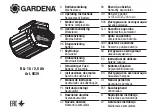
10
Rev. 0
The DC2732A demo board can be operated in four differ-
ent setup options.
1. Nonisolated SPI interface with DC2026 (Linduino)
Options 2 thru 5 are isolated.
2. isoSPI interface with DC2617 (CAN to isoSPI shield)
plugged on top of DC2026 (Linduino)
3. isoSPI interface with DC1941 (LTC6820 SPI to isoSPI
bridge) connected to DC2026 (Linduino)
4. isoSPI interface with DC2792 (dual LTC6820 SPI to
isoSPI bridge) connected to DC2026 (Linduino)
5. isoSPI interface parallel to a reversible daisy chain of
cell monitors (as above with DC2792, DC2026)
For option 1, the LTC2949 is supplied with 7V by
Linduino. In all other cases a 5V to 12V (or up to 32V,
HARDWARE SETUP EXAMPLES
see performance summary) supply needs to be connected
to turrets LGND and V
CC
on the lower left side of the demo
board.
For option 1, the LTC2949 is galvanically connected to
the Linduino. Still, the Linduino has a galvanic isolation
to its USB port. For the other two options, the commu-
nication and supply to LTC2949 is isolated by an isoSPI
transformer and flyback converter.
Make sure to set the SPI/isoSPI selection jumpers J3–J6
to the correct position depending on the chosen option
(SPI for option 1, isoSPI for all other options).
In all setups it is possible to operate LTC2949 together
with cell monitors ADBMS68xx/LTC681X. As the DC2732A
has two RJ45 isoSPI connectors, this is especially easy
when operating in isoSPI mode, as shown in option 5.
Figure 4 thru Figure 6 show how DC2732A is configured
and connected with above mentioned demo circuits.
OPTION 1: NONISOLATED SPI SETUP
Figure 4. Nonisolated SPI Communication and Supply via Linduino (Linduino’s USB Port is Still Isolated). Supply via Turrets V
CC
,
LGND is Not Necessary in This Setup; This is Also the Recommended Initial Setup when Using the GUI Software, the First Time as It
Allows Easy GUI Installation via QuikEval; After the GUI is Installed Any Other Setup Can Also Be Used












































